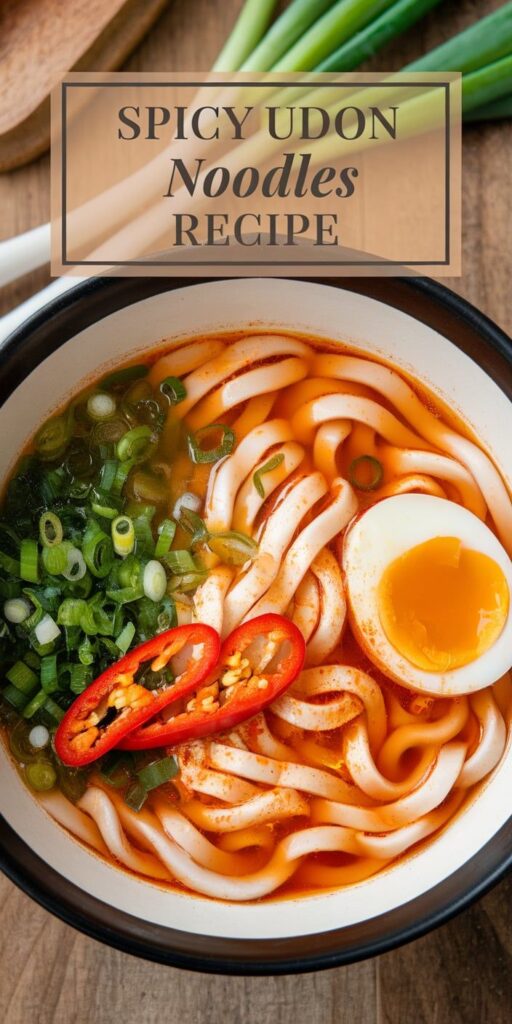Craving a delicious and easy udon recipe that brings restaurant-quality flavor to your kitchen? This quick stir-fry dish transforms simple ingredients into an explosion of spicy Asian noodles that will tantalize your taste buds.
Homemade udon noodles are the star of this incredible recipe, offering a perfect blend of chewy texture and bold, spicy flavors. Whether you’re a busy home cook or a passionate food enthusiast, this dish promises to deliver an authentic culinary experience in just minutes.
Packed with vibrant ingredients and a kick of heat, these spicy udon noodles will become your new go-to meal when you want something exciting and satisfying. Get ready to impress your family and friends with this simple yet spectacular recipe.
Essential Ingredients for Perfect Spicy Udon Noodles Recipe
Creating delicious spicy udon noodles starts with selecting the right ingredients. The magic of this dish lies in balancing flavors, textures, and high-quality components that transform a simple meal into a culinary adventure.
Fresh vs. Dried Udon Noodle Types
Choosing the right udon noodle types can make or break your recipe. Fresh udon noodles offer a softer, more delicate texture and cook faster. They absorb spicy Asian sauce more effectively and provide a smoother mouthfeel. Dried udon noodles, while convenient, require careful cooking to achieve the perfect al dente consistency.
- Fresh udon: Refrigerated, softer texture
- Dried udon: Longer shelf life, requires precise cooking
- Thickness variations impact overall dish quality
Crafting the Perfect Spicy Asian Sauce
The soul of spicy udon noodles lies in its sauce. A balanced spicy Asian sauce combines multiple flavor profiles to create depth and complexity. Key ingredients include soy sauce, chili oil, garlic, and ginger.
- Soy sauce: Base flavor
- Chili oil: Heat and depth
- Sesame oil: Nutty undertones
- Rice vinegar: Tangy brightness
Protein and Vegetable Stir-Fry Ingredients
Elevate your udon noodle toppings by selecting proteins and vegetables that complement the spicy sauce. Proteins like chicken, shrimp, or tofu provide substance, while crisp vegetables add texture and nutritional value.
- Protein options:
- Grilled chicken
- Pan-seared tofu
- Sautéed shrimp
- Vegetable recommendations:
- Bell peppers
- Green onions
- Mushrooms
How to Achieve Restaurant-Style Udon Texture
Mastering the art of cooking udon noodles requires precision and technique. Professional chefs know that achieving the perfect al dente udon is about understanding the delicate balance between cooking time and water temperature.

The key to creating a chewy noodle texture starts with proper udon noodle preparation. Fresh udon requires a different approach compared to dried varieties.
- Use a large pot with plenty of water
- Stir noodles gently to prevent sticking
- Test noodles for doneness early
- Rinse with cold water to stop cooking process
Water temperature plays a critical role in developing the signature bouncy texture. Boil water at a rolling temperature and maintain consistent heat throughout cooking.
| Noodle Type | Cooking Time | Texture Goal |
|---|---|---|
| Fresh Udon | 2-3 minutes | Soft yet firm |
| Dried Udon | 8-10 minutes | Chewy and elastic |
Professional chefs recommend watching noodles closely and removing them from heat just before they reach complete tenderness. This technique ensures the udon maintains its distinctive al dente consistency.
Cooking Instructions and Serving Suggestions
Master the udon stir-fry technique by starting with perfectly cooked noodles. Bring a large pot of water to a rolling boil, then add fresh udon noodles. Cook for 2-3 minutes until they separate easily, then drain and rinse with cold water to stop the cooking process.
Follow these spicy udon recipe steps carefully. Heat a large wok or skillet over high heat, adding a tablespoon of sesame oil. Quickly sauté your chosen protein until it’s just cooked through. Remove the protein and set aside. In the same pan, add your prepared spicy sauce, creating a vibrant base for your dish.
Udon noodle plating becomes an art form with the right technique. Toss the cooked noodles into the sauce, ensuring each strand is evenly coated. Return the protein to the pan and mix gently. The key is to create a harmonious blend of flavors and textures that dance together in each bite.
Elevate your dish with udon noodle garnishes that add both visual appeal and extra flavor. Sprinkle toasted sesame seeds, finely chopped green onions, and a light dusting of togarashi for an authentic touch. For those who love extra heat, serve with a small dish of chili oil on the side, allowing diners to customize their spice level to perfection.





